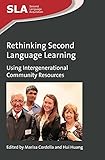Rethinking Second Language Learning : Using Intergenerational Community Resources / ed. by Marisa Cordella, Hui Huang.
Material type: TextSeries: Second Language AcquisitionPublisher: Bristol ; Blue Ridge Summit : Multilingual Matters, [2016]Copyright date: ©2016Description: 1 online resourceContent type:
TextSeries: Second Language AcquisitionPublisher: Bristol ; Blue Ridge Summit : Multilingual Matters, [2016]Copyright date: ©2016Description: 1 online resourceContent type: - 9781783095407
- 9781783095414
- Second language acquisition--Research
- LANGUAGE ARTS & DISCIPLINES / Study & Teaching
- SLA
- Second Language Acquisition
- aged care management
- community engagement of older people
- discourse analysis
- diverse linguistic and cultural backgrounds
- healthy ageing
- intercultural encounters
- intergenerational encounters
- intergenerational relations
- language acquisition
- language pedagogy
- multiculturalism
- older native speakers
- second language learning
- sociolinguistics
- understanding between generations
- 401.93
- P118.2 ǂb .R484 2016eb
- online - DeGruyter
- Issued also in print.
| Item type | Current library | Call number | URL | Status | Notes | Barcode | |
|---|---|---|---|---|---|---|---|
 eBook
eBook
|
Biblioteca "Angelicum" Pont. Univ. S.Tommaso d'Aquino Nuvola online | online - DeGruyter (Browse shelf(Opens below)) | Online access | Not for loan (Accesso limitato) | Accesso per gli utenti autorizzati / Access for authorized users | (dgr)9781783095414 |
Frontmatter -- Contents -- Figures and Tables -- Transcription Conventions -- Acknowledgements -- Contributors -- Introduction -- Part 1: Setting the Scene: Many Cultures, Many Opportunities -- 1. The Immigrant Potential: Multiculturalism, Language Skills and Community Resources -- 2. Contemporary Intergenerational Relationships -- 3. Community Resources on our Doorstep: Language Learning in Action -- Part 2: Constructing Identity: The Self-Presentation of Older Native Speakers -- 4. Taking a Stance: Older Native Speakers with Young Language Learners -- 5. The Migration Experience and the Ethos of Self -- 6. 'Who Are We?' Self-Referencing in Chin ese and German Conversations Using the First Person Plural -- 7. Creating, Maintaining and Challen ging Rapport Across Languages and Age Groups -- 8. 'I feel very happy that I can contribute to society': Exploring the Value of the Project for Older People -- Part 3: Situated Learning: Enhancing the Opportunities for L2 Students -- 9. Gaining L2 Self-Confidence in Conversations with Native Speakers -- 10. Developing Interactional Competence in Dyadic Conversations: Cross-language Evidence -- 11. An Innovative Model for Second Language Learning and Social Inclusion -- Index
restricted access online access with authorization star
http://purl.org/coar/access_right/c_16ec
This book evaluates a project where formal classroom learning of a second language was supplemented with informal, natural interactions with older native speakers of the target language, delivering a number of pedagogical and societal benefits. The authors introduce a model of intergenerational, intercultural encounters which aims to promote the use of community language resources; enrich the experiences of young learners; foster greater understanding between generations; break down cultural stereotypes; encourage appreciation of different cultures and enhance the quality of life and community engagement of older people with a bi/multilingual background. It draws on theories of language acquisition, discourse analysis and psychosocial perspectives to propose a model of language learning for students that can be used for any language or locality. It is therefore an essential resource for graduate students, researchers and language teachers as well as for education, aged and youth care policy makers, practitioners and community services workers who are interested in innovative language pedagogy.
Issued also in print.
Mode of access: Internet via World Wide Web.
In English.
Description based on online resource; title from PDF title page (publisher's Web site, viewed 24. Apr 2022)


